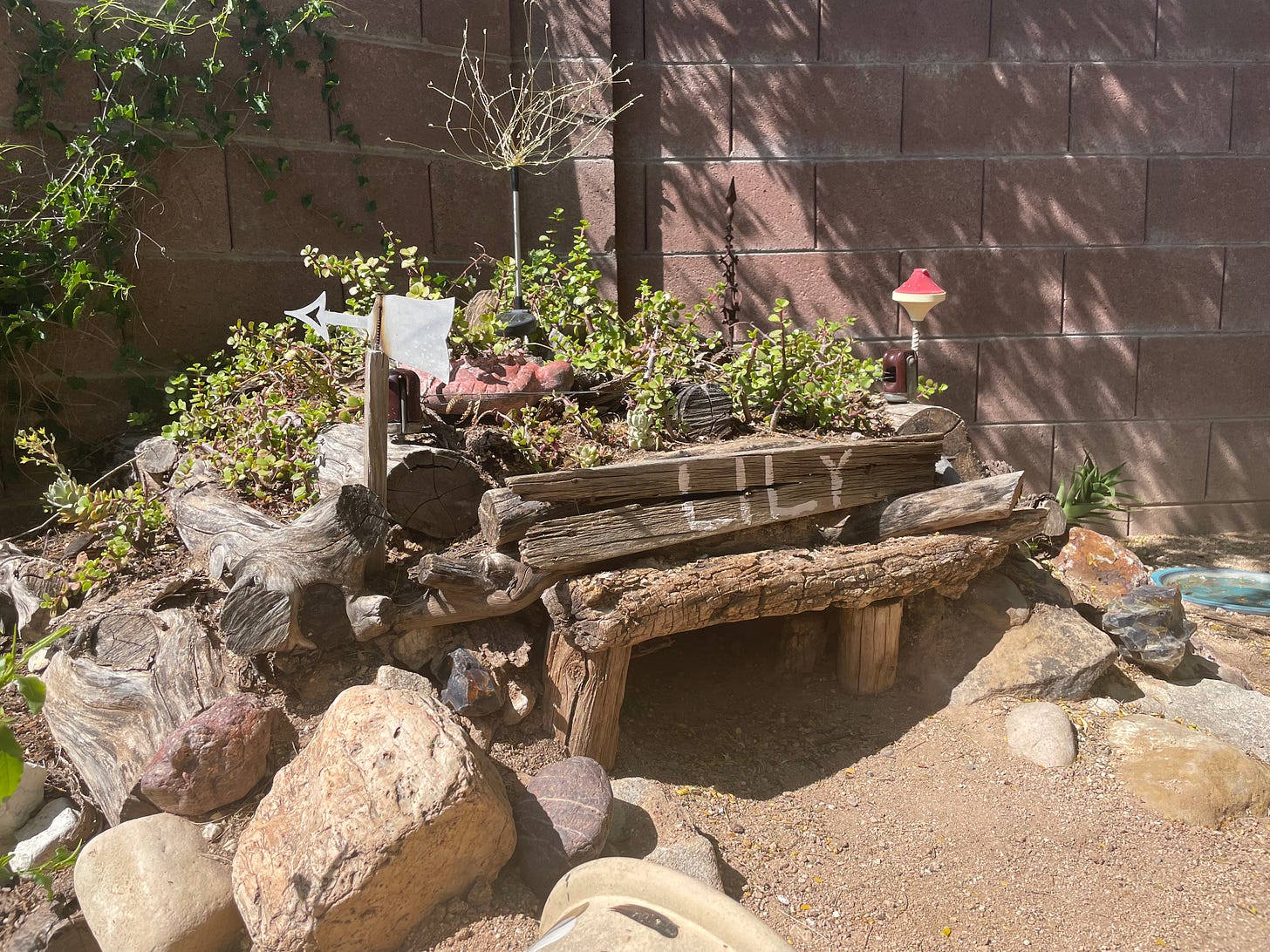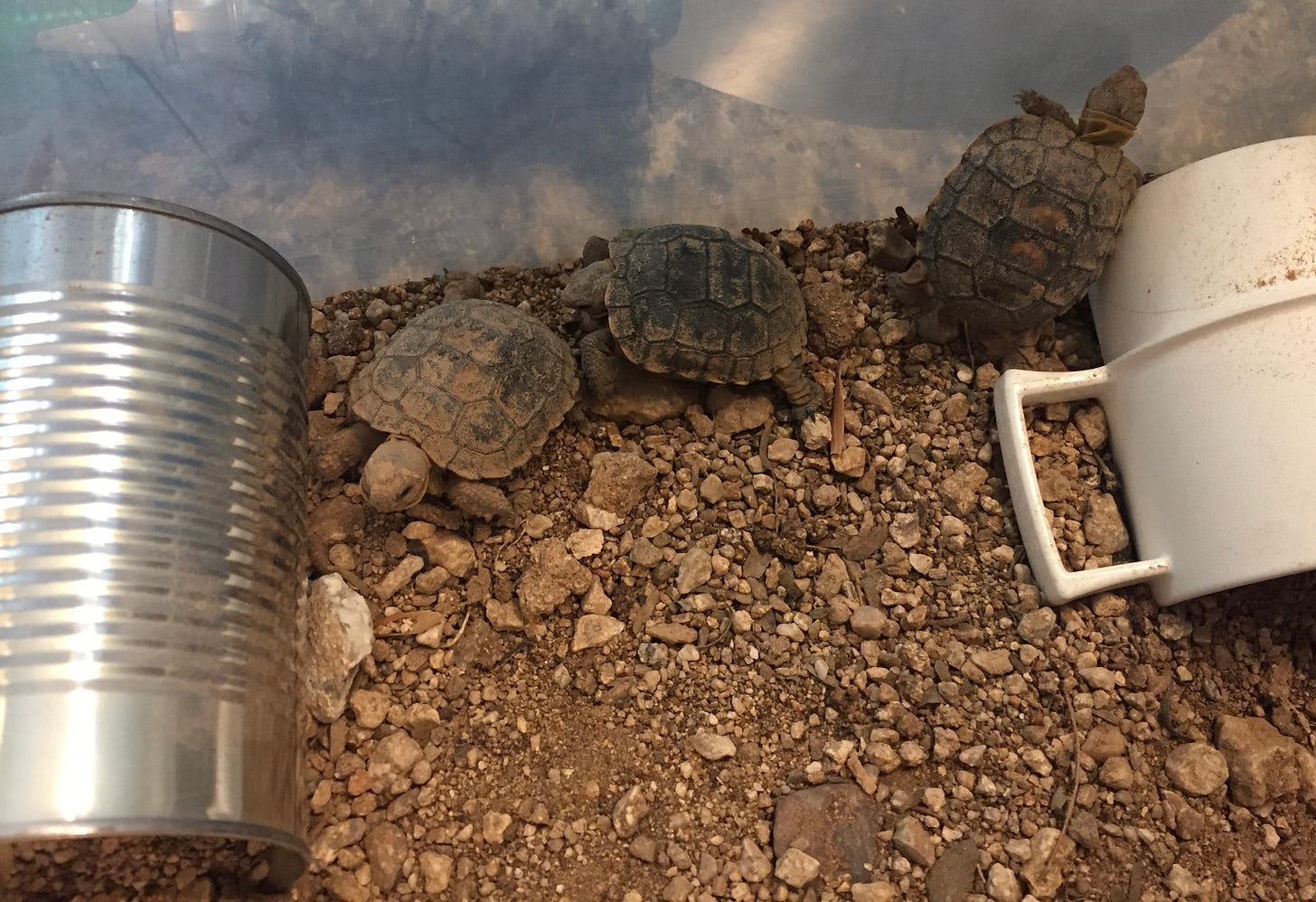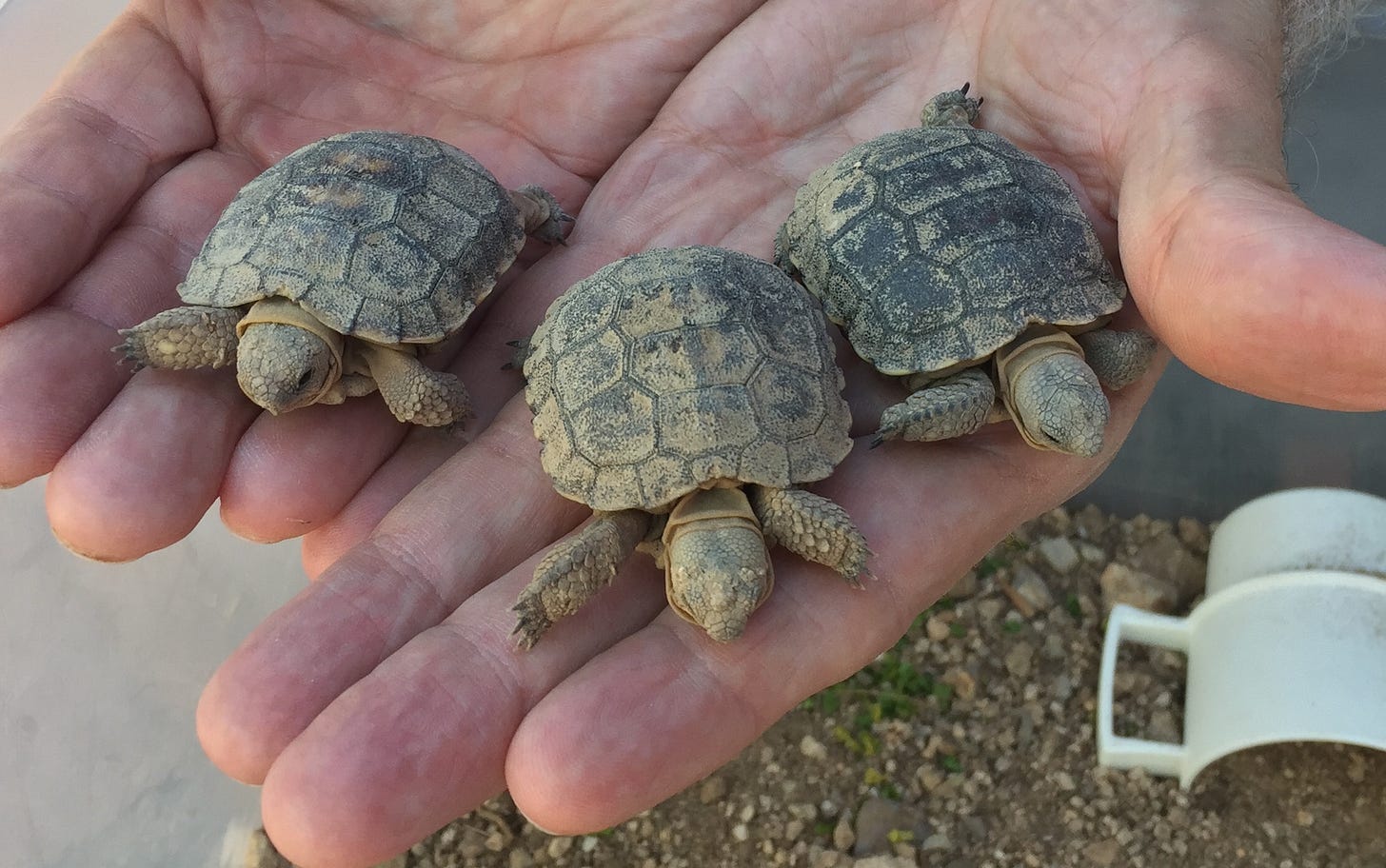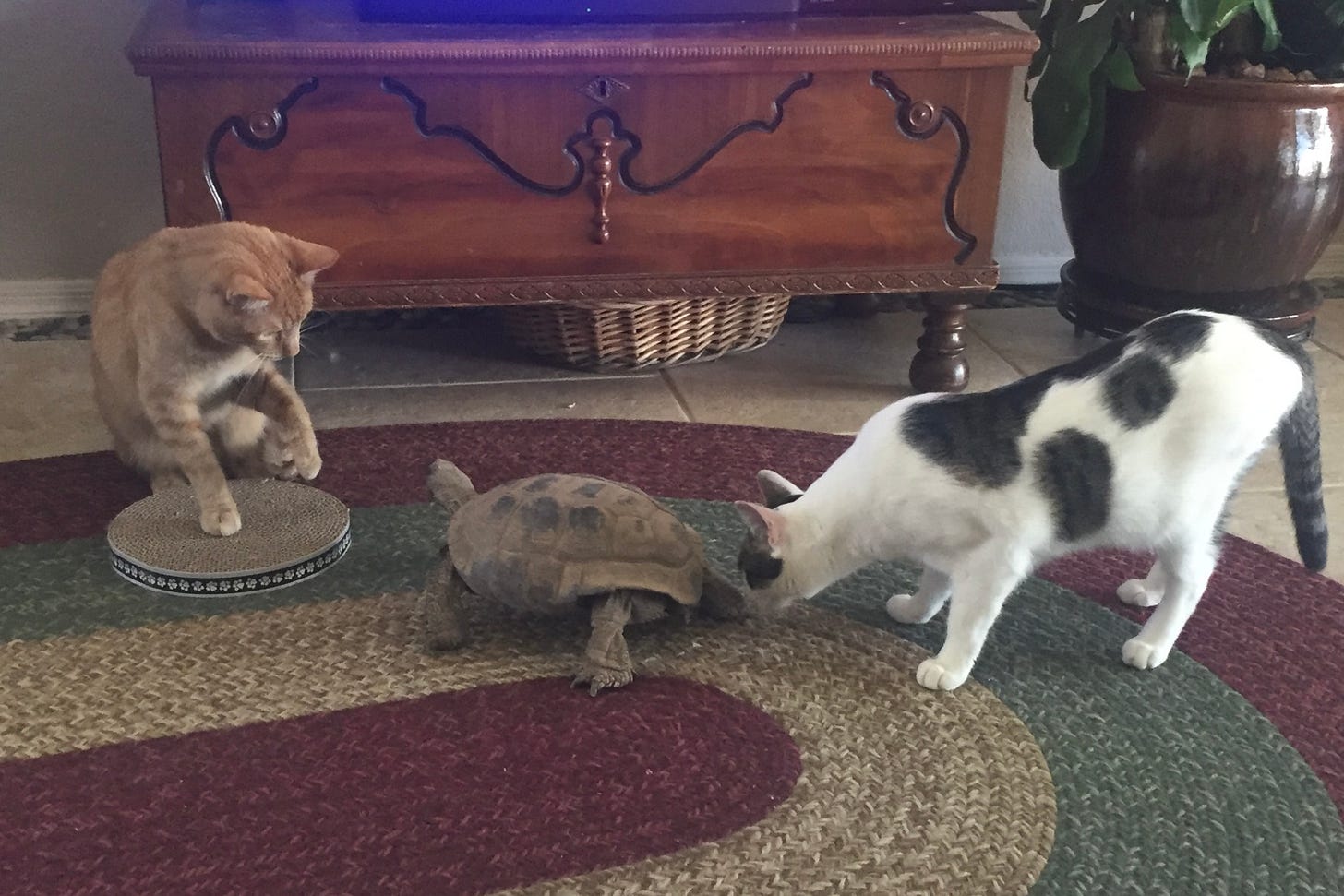We have a desert tortoise living in our backyard. We named her Lily for no particular reason. She just looks like a Lily, I guess. We got her five years ago from the local Desert Museum. They run a program for tortoise adoptions. The state Game and Fish Department runs a tortoise adoption program, too. Apparently, there are hundreds of desert tortoises in need of a good home. These are tortoises that for whatever reason cannot be released into the wild.
I should clarify, technically speaking, we did not “adopt” Lily. We do not own her. We are “custodians”.
There is an online application to fill out, and there are several requirements that must be met. The first thing is to have a walled-in yard so that the tortoise cannot escape. And the yard must be big enough to give the tortoise room to roam, at least a little bit. An inspector was sent out to assess the suitability of our yard as a potential tortoise habitat. We passed the inspection and a week or two later, we were invited to come out to the Desert Museum and pick out a tortoise.
Prospective caretakers have to provide some kind of shelter for the tortoise. We built Lily something really nice, if I do say so myself. We got a load of fill dirt to build up the area in our yard where we wanted to put Lily’s shelter. Then we went to one of the big box hardware stores and got 6 standard sized cement blocks and a sheet of plywood. We arranged the blocks in a squared-off U, put the plywood on top and covered it with leftover dirt.
But that seemed kind of, I don't know, blah. We wanted her to have someplace attractive, as well as functional. We gathered up some big decorative rocks we had elsewhere in the yard and placed them around the outside of her shelter to best keep the dirt in place. We had some large mesquite branches back there that we cut to the right size and put them on top of the dirt and filled in the spaces between them with more dirt. My wife then planted some wildflowers and succulents. It really is quite nice.
We had been warned that tortoises are diggers and Lily proved this by digging under the cement blocks. This seemed as though it might be a problem, mainly because we were concerned that if she kept digging under the blocks, one might fall in on her. So, we dismantled her palatial tortoise estate, and dug a U shaped trench deep enough to put the blocks in, got 6 more blocks to put on top of the originals, then reassembled it. When she tried to dig under the blocks, she hit another row of cement, which discouraged her from digging under there. We do not have to worry about her getting crushed under a cement block anymore.
We received another warning about Lily when we picked her up. Our contact at the Desert Museum told us that Lily had been with a male earlier in the spring, but they were unsure if anything had happened between them. Well, apparently, there was a love connection because a few months later I was walking in the backyard and I saw something move out of the corner of my eye. It was a baby tortoise! I almost stepped on him. The next day there was another. We found another one the day after that.
Baby tortoises are fully formed when they hatch. The mother guards the eggs but after the babies emerge, they are on their own, she has nothing to do with them. Being that small, they are vulnerable to predators. The DM person told us that if we did see any hatchlings, we could bring them over and drop them off. But we could not get there for a few days, so we had to figure out a way to protect them. We put them in a plastic storage crate with some dirt and a couple of tin cans and a cup to allow them to hide if they so chose. There were two problems with that approach. One - the plastic crate was semi-clear, not opaque, so they continually tried to climb the walls, resulting in them turning themselves over, which is dangerous because they could die if they could not right themselves. And the second problem was that we both worked, so that would have meant leaving them alone. And we couldn’t do that because of them turning themselves over. What to do?
Well, the solution was that I took them to work with me in the crate. I put them on a book cart and wheeled them around with me wherever I went. Several times an hour, I had to flip a baby tortoise, but they survived until the end of the week. (Thankfully at the end of each day, they would be all tuckered out and sleep ‘til morning, so at least we didn’t have to stay up all night.) That Saturday, we dropped them off at the Desert Museum and hopefully they were adopted out to good homes.
Generally speaking, reptiles are not known for being cuddly and expressive, and while Lily is no exception, she does seem to enjoy being lightly scratched under her chin. I do think she knows us and does not appear to fear us, as evidenced by the fact that she regularly comes to our back door and kind of thunks her shell along the glass, looking for a way in. We’ll slide the door open and most of the time, she will clamber over the threshold and come in for a visit. Sometimes Lily will roam around, going from room to room, looking for who knows what, before finding a hiding place. Other times, she seems to know exactly where she wants to go.
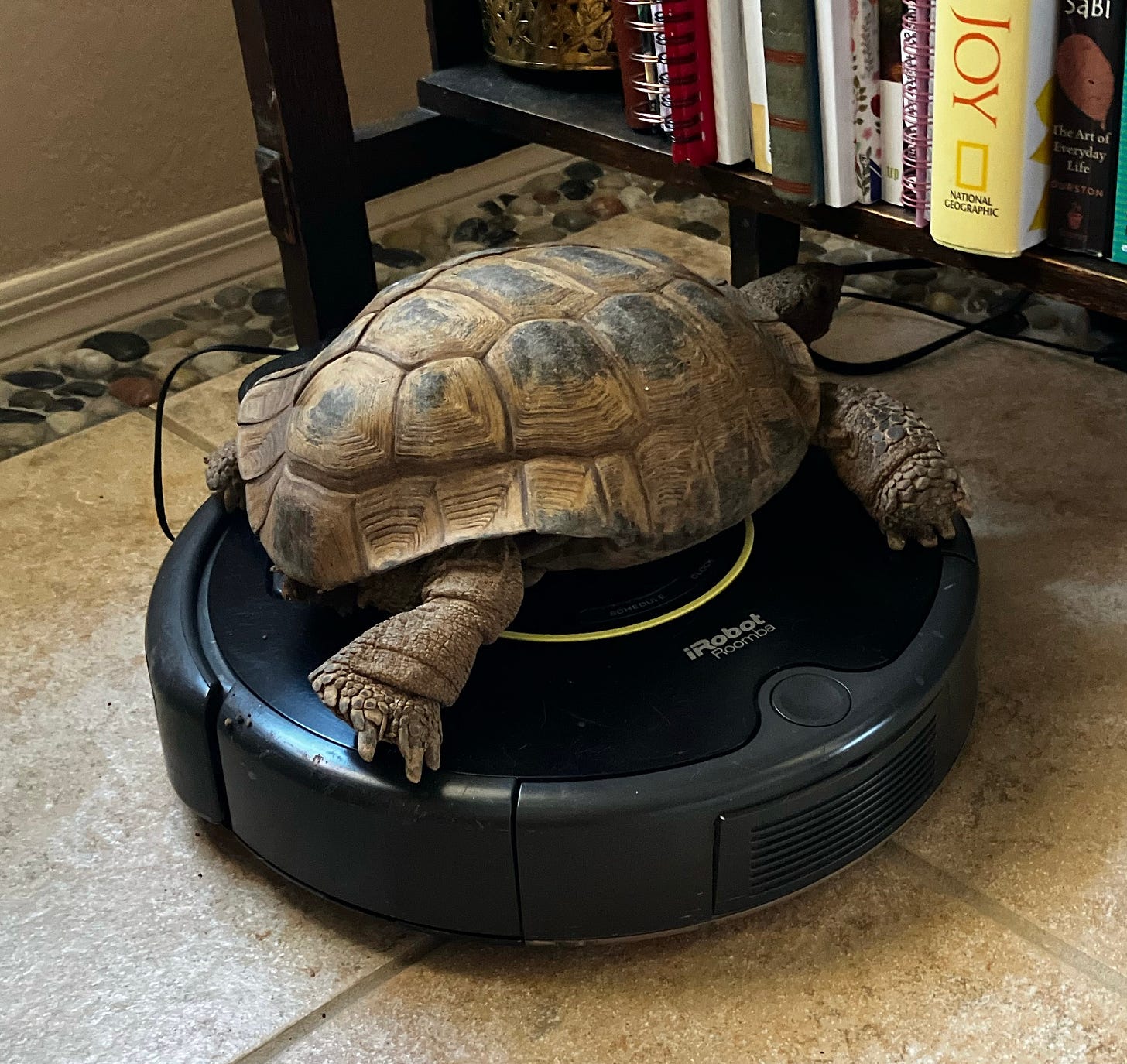
She has several favorite places in the house - under our bed, my wife’s sewing room, the guest bathroom - and often she’ll head straight for one of those places and stay there until morning. Then we put her out, so she can get some fresh air and sunshine. Lily is not housetrained, so occasionally there is a mess to clean up. We agree, though, that it is a small price to pay to have her come inside to visit.
People often wonder, “What does Lily eat?” Lily likes to browse on weeds in the yard, which is my excuse for not being too fastidious about addressing the weed problem back there. We do give her a lovely breakfast salad every morning. Her favorite foods include: kale, dandelion greens, collard greens, prickly pear fruit, watermelon, cantaloupe, and blueberries. We harvest the prickly pear fruit in the late summer-early fall and freeze them. Then we thaw them out as we use them when Lily comes out in the spring.
Technically, Lily does not hibernate. Bears hibernate, reptiles brumate. Brumation is described as a state of lethargy, hibernation is more of a deep sleep. Lily brumates outside throughout the winter, going into her den anytime from mid-October to mid-November. She usually emerges in mid to late April. Sometimes, though, she will come out in March for a day or two, then go back in for another month.
Tortoises have lived in this area for many millennia, so they know what they are doing, but I worry about Lily being in her den in the winter when the temperatures get close to or below freezing. So, I get a long extension cord from the garage and an old heating pad and put it inside the entrance to her den. Possibly it is not necessary to do that, but I do it anyway, I guess to help me feel better more than anything.

It might sound kind of silly, but it is a special event when Lily comes out of her tortoise mansion. One of us will see her in the yard and holler, “Lily’s out!” Perhaps we are easily amused, but it is very exciting to watch her make her way slowly around the yard, doing tortoise stuff. She is surprisingly charismatic. Lily has been way more fun than we ever would have imagined. We are quite happy she is part of our family.





